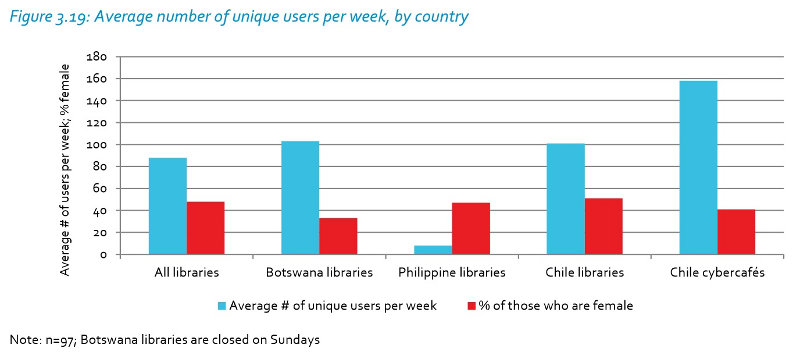How Botswana’s public libraries connect people to ICTs
Recently, The Technology & Social Change Group (TASCHA) at the University of Washington Information School announced the release of their latest report, Public libraries connecting people for development: Findings from the Global Impact Study. The five-year study was designed to generate evidence about the scale, character, and impacts of public access ICTs. From it, we can get generalize how the typical public library venue user in Botswana accesses the internet.
Abstract:
Using data from Botswana, Chile, and the Philippines, this report summarizes the study’s key findings with a focus on libraries, situating these venues in the context of national development, discussing some disputed issues, and providing recommendations for policymakers, library practitioners, and researchers. The results show that a central impact of public libraries is promoting digital inclusion, information access, and development of ICT skills through technology provision, particularly for marginalized populations and those who face challenges using and benefiting from computers and the internet. The data also suggest a number of library characteristics that are important to users and provide a unique public value, with both users and non-users reporting positive impacts and a willingness to pay to maintain the existence of public libraries.”
Findings as they relate to the case of Botswana’s public libraries
Landscape and Realities:
- On average, a library has 8 computers available for public use
- There were about 100 unique users per week across Botswana libraries
- 68% of workstations could accommodate wheelchairs
- All connections were DSL
Profile:
- 93% of libraries report a lack of computers to meet user demand
- 73% of libraries said internet speeds were adequate
- Free in-house computer training was available in 78% of libraries
- 86% of staff were trained on running the venue
- Only 8% of users reported online restrictions discouraged user traffic
- Students made up half of users
- 89% reported income about the poverty line
- 13% of users also had home access to the internet
- 51% first used the internet 3+ years ago
- 29% had no other option for internet access
- 87% visited the venue at least weekly
- 43% lived less than 1km from the library
Digital Inclusion:
- 75% of user had their first internet use at a public access venue (equal between men and women)
- School access was more important that public access and home access
- 50% of searches were for education-related material
Impacts by User Population:
- 41% of users with a university education reported a positive impact by public access venues on income
Source: Sey, A., Coward, C., Rothschild, C., Clark, M., and Koepke, L. (2013). Public libraries connecting people for development: Findings from the Global Impact Study. Seattle: Technology & Social Change Group, University of Washington Information School.













 Twitter
Twitter Facebook
Facebook Pinterest
Pinterest